The travel bug has bitten me once again! I have been a world traveler my entire adult life and found it challenging to stay put the last two years, though I did gain a lot from doing so. My first trip since the beginning of the pandemic was my glorious Christmas holiday to Tombstone Monument Ranch and since then I have been plotting more trips this year. I am so thankful that I can move from place to place in comfort and ease, at least compared to Victorian women. Taking a trip alone in the 19th century was a hefty undertaking, with possibly hundreds of pounds of clothing packed in sturdy trunks. I sure am thankful for the jeans and tank tops I carry in my trusty suitcase on wheels!
Victorian traveling dress was something well-discussed in the etiquette manuals of the time as well as in women’s magazines. The rules outlined may make you feel better about the luggage restrictions most airlines have today.
Victorian traveling dress: guidelines for proper ladies
Dress modestly…and sensibly
Some aspects of Victorian life may not have been concerned with convenience and sensibility; traveling was not one of them. The etiquette manuals from the time stress the importance of clothing that is designed to add more ease to a trip over and over. It was also emphasized that clothing worn while traveling should be simple and made for wear. Says 1870’s The Art of Dressing Well. A Complete Guide to Economy, Style, and Propriety:
“A lady’s dress is never more exposed to criticism than when she is travelling, and there is no surer index of her taste and skill in the art of dressing well than is shown in this important costume. Vulgarity of taste will dictate a conspicuous style, utterly abhorrent to a refined eye, while quiet elegance is ever more attractive than in a travelling companion.”
And as for the outfit itself, a general guideline:
“A collar and cuffs of plain linen, fastened by a simple brooch and buttons, kid boots, and strong gloves, are in the best taste. A hat is generally more convenient than a bonnet, and should be of straw in summer, and felt in winter, simply trimmed. Any fancy material, lace or velvet, is in excessively bad taste in a travelling hat.”
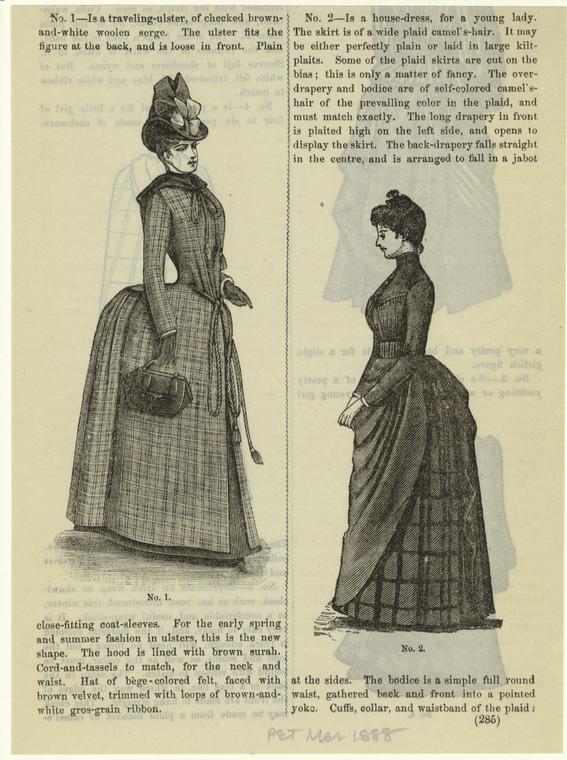
Image source: New York Public Library
But don’t start packing yet! The specifics for what constitutes a proper travel dress is something the author, S.A. Frost, would not gloss over. Want to plan your own Victorian traveling dress? Keep these guidelines in mind:
“A travelling-dress should always be made quite short, and the underskirts should be of woolen in winter, and dark linen in summer, white petticoats will not look well but a very short time on a journey.”
“Travelling-dresses, when the season permits, should be made of wash maternal. Nothing is so tenacious and disagreeable as the dust contracted in travel, and once settled in wollen goods it is almost impossible entirely to dislodge it.”
Two garments are indispensable in the wardrobe of a lady who travels much. A waterproof cloak with a large hood, and a full, loose, linen duster, to entirely cover the dress…It is not always possible to tell which will be the most required upon a long journey, but it is generally safest to have both where they can be conveniently unpacked.”
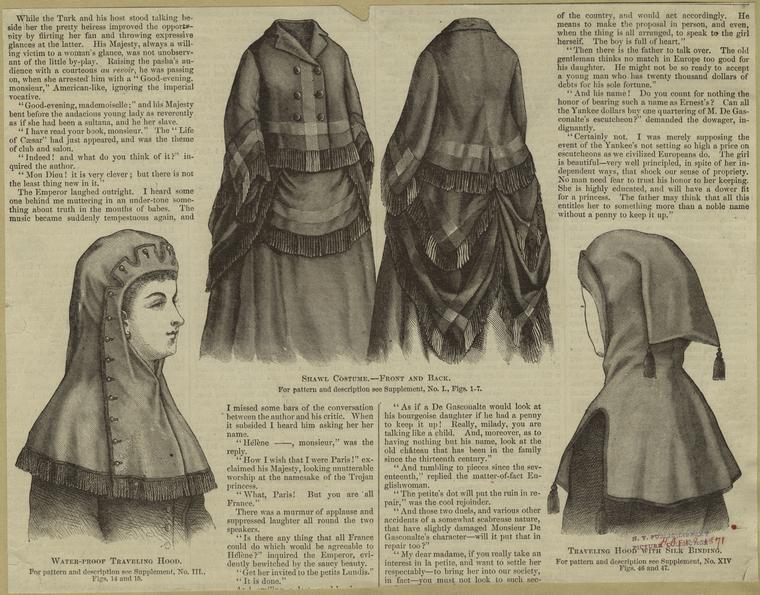
Image source: New York Public Library
Avoid the look of dust: pack colored underpinnings
The conveniences of modern travel are more clear when reading Victorian literature on planning for a trip, as the filth and dust involved is often mentioned. I found it really interesting that women were encouraged to wear and pack colored underthings, which would have been considered very poor taste and just plain strange during any other time. The Art of Dressing Well advises:
“Where a journey is to be very long, especially in the winter, colored stockings, colored linen corsets, and colored skirts, will be found much more serviceable than white ones, especially if there is no stop to be made for washing.”
“There is no economy in cheap corsets, and an ill-fitting pair will spoil the beauty of the most perfectly fitted dress. Colored corsets are only suitable for traveling, but will be found then a useful addition to the wardrobe.”
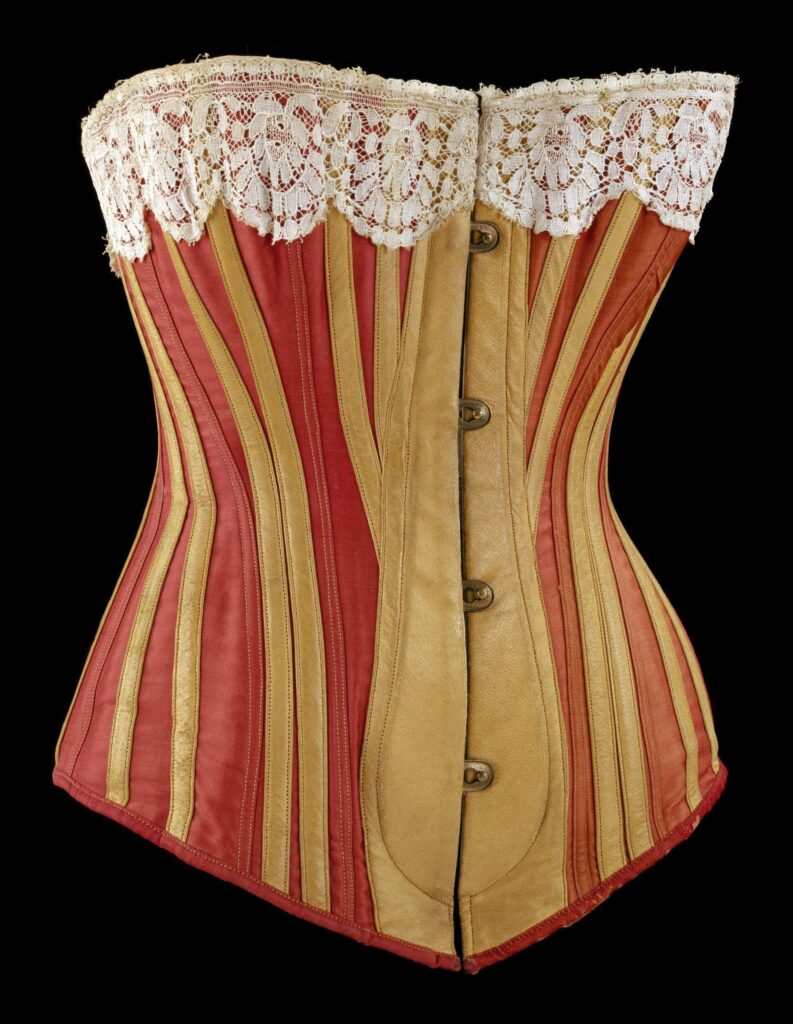
1883, V&A Museum
Pack your trunk!
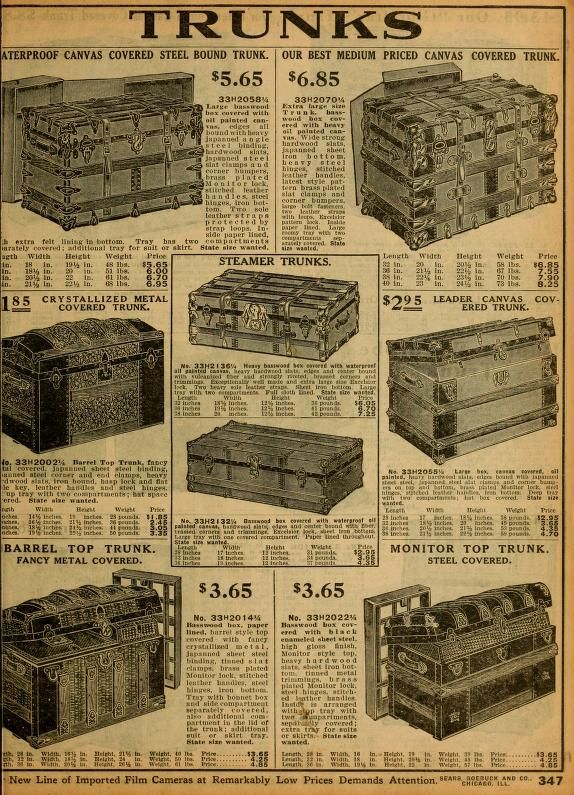
Once a Victorian lady had gathered a selection of sturdy traveling dresses in neutral tones and managed to find colored underpinnings it would be time to pack. I discovered while researching for this post that suitcases did not emerge onto the market until the very late 1800s, and then slowly. A wonderful Smithsonian article on the topic reads:
“An 1897 wholesale price list included the words “suit case” only twice in a 20-page list of luggage types. In a 1907 T. Eaton & Co. catalog, trunks took up a full page while suitcases share a page with club bags and valises. In a 1911 United Company catalog, however, around 40 percent of the advertisements were for suitcases. (It’s worth pointing out that these catalogs were from North America, where migration required people—and not just the wealthy—to carry their own belongings far and often).”
Before suitcases caught on, travelers would somehow travel around with large, bulky, heavy, trunks. The heavier the better, as trains and ships required trunks to be tossed around and often wet.
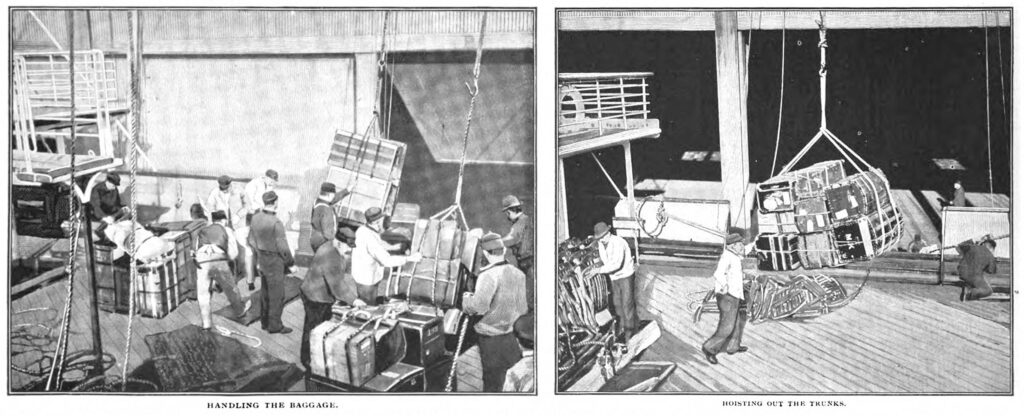
The fashionable Madame Demorest’s semi-annual What to Wear and How to Make It, both sold trunks and advised on what type to purchase:
“Ladies who travel with elaborate outfits, involving the transportation of a number of costumes, find it convenient to have one or more trunks without compartments, and furnished with a succession of large trays in which dresses may be laid, without the possibility of undue pressure from above.” (1878)
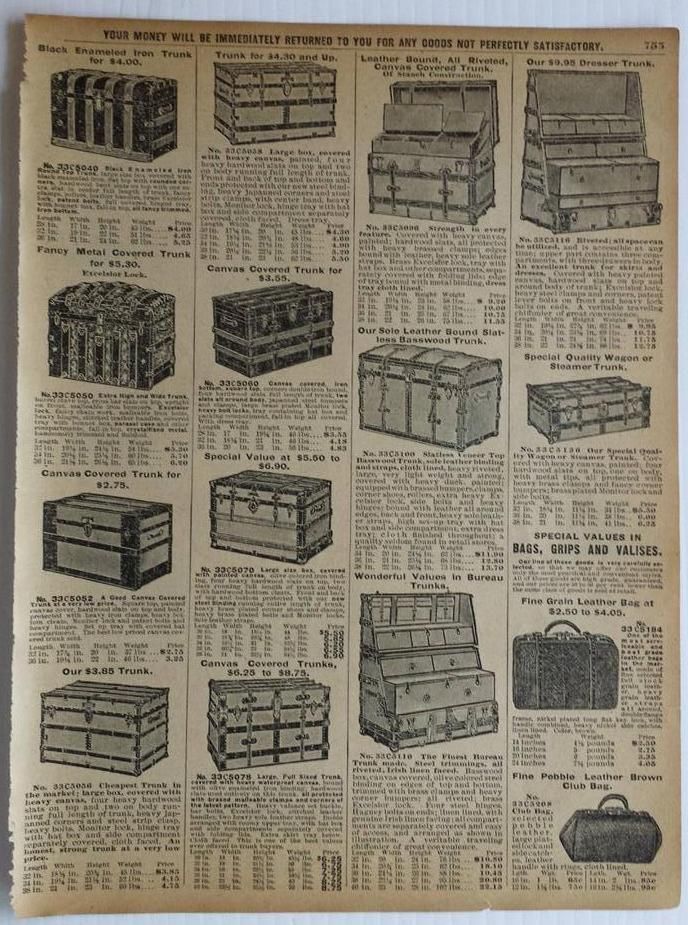
Read more about Madame Demorest in our entire blog post on her life and career: Ellen Demorest: Victorian fashion icon.
And don’t go thinking that packing one’s trunk was left to the night before their departure. The Art of Dressing Well states:
“To pack a trunk neatly, everything should be laid out in readiness, neatly folded and sorted, the light articles divided from the heavy ones, and a supply of towels and soft wrapping-paper at hand. Spread a thick, clean towel over the bottom of the trunk, and place upon it the hard, flat things, such as the portfolio, workbox, jewel-box, music-books, writing desk, and boxes; take care to fit them well together, so as to be level on top, filling in crevices with such small articles as well not be injured by compressment, as stockings, towels, or flannels. Wrap all polished boxes in soft paper before packing, and guard the corners well from rubbing against each other…” [sic]
The book goes on for an entire page and a half more about how to properly pack a trunk before traveling.

More guidelines for traveling like a Victorian lady
“Among minor articles, money belts are usually considered essential, and ladies generally prefer to carry their valuable jewelry in a small bag or satchel of Russian leather or sheepskin, which is firmly attached to a belt of the same. This is considered safer than to bestow precious articles in a trunk.” –What to Wear and How to Make It
“Jewelry, artificial flowers, lace, or finery of any kind in a traveling-dress, will prove the most vulgar desire for display, and conspicuous colors are in as bad taste.” –The Art of Dressing Well
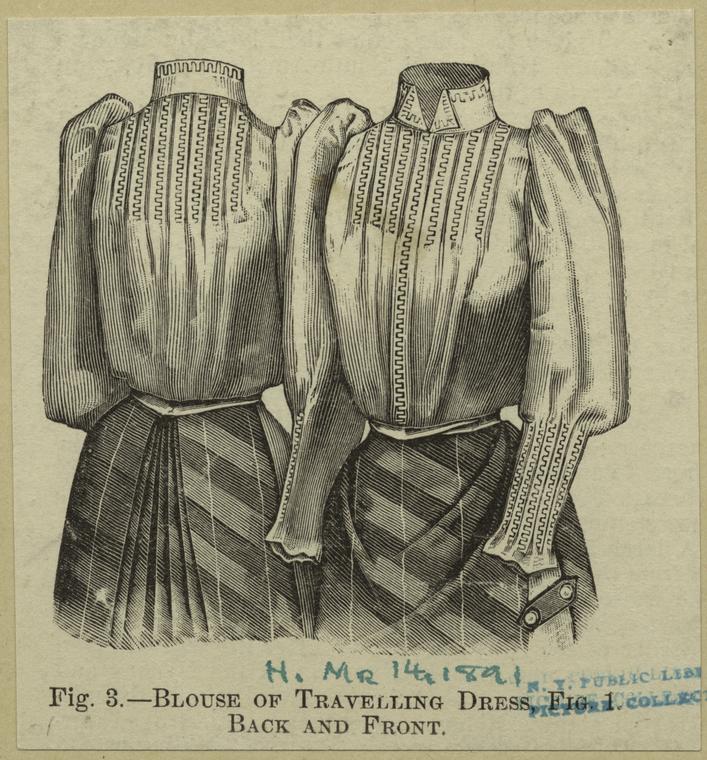
Image source: New York Public Library
“It is better taste to wear the hair in smooth, compact style, than in curls or any flowing fashion, and it will be more likely to escape injury by railroad cinders and the dust of travel.” –The Art of Dressing Well
“A lady’s dress, when alone at a hotel, should be of the most modest kind. At breakfast let her wear a close, morning dress, and never, even at supper, appear alone at the table with bare arms or neck. If she comes in late from the opera or a party, in full dress, she should not come into the supper-room, unless her escort accompanies her. A traveling or walking-dress can be worn with perfect propriety, at any meal at a hotel, as it is usually travelers who are the guests at the table.” –The Ladies’ Book Of Etiquette, And Manual Of Politeness, 1860
More Victorian fun:
Godey’s Lady’s Book: what you didn’t know
Mind your manners! Victorian table etiquette

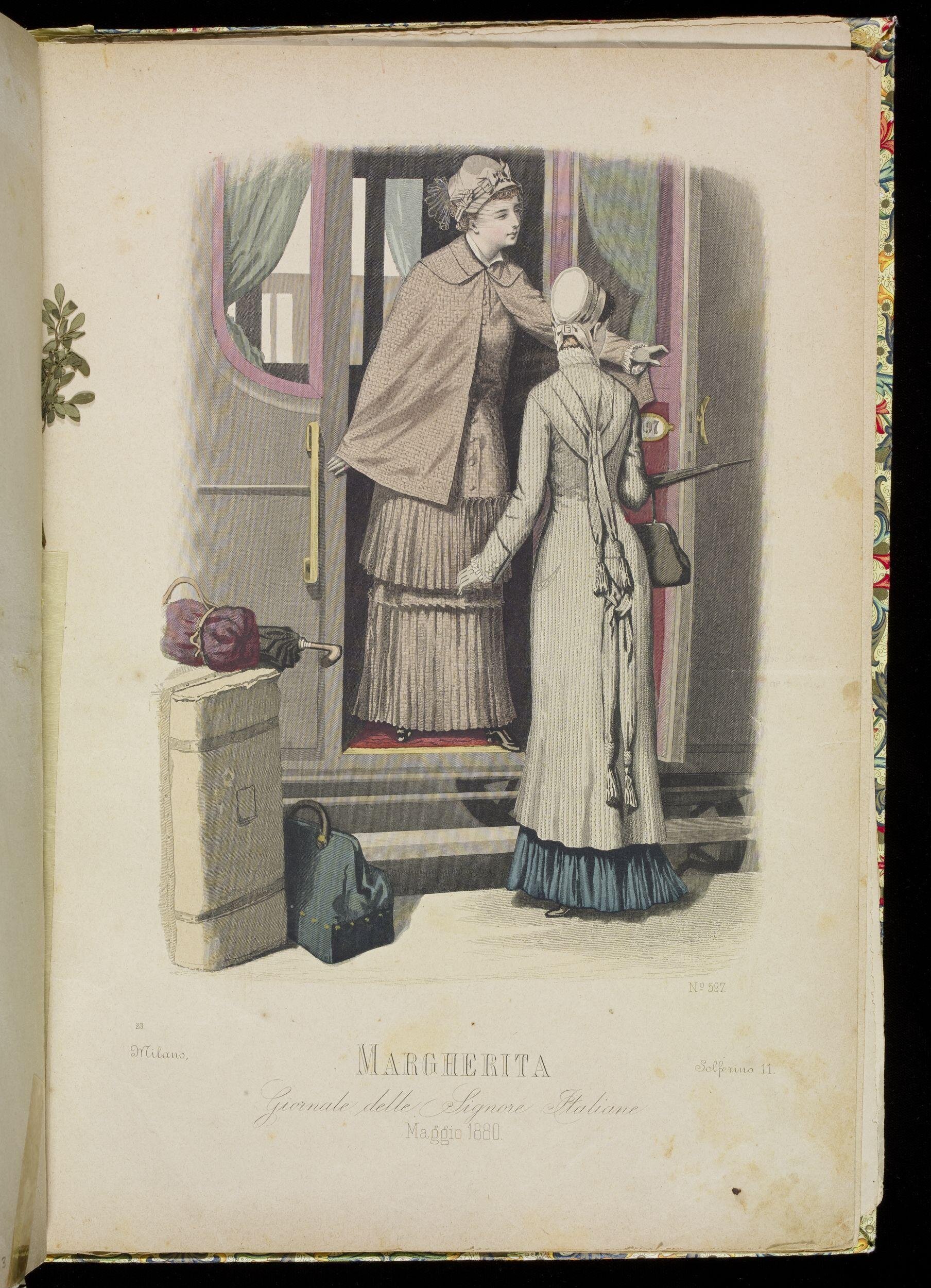












Seems to me DUST was the major enemy of traveling ladies at that time. Most probably at home too, especially if your sod home out here on the plains had a dirt floor! ?